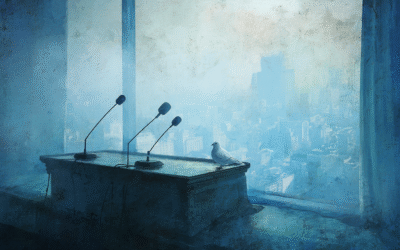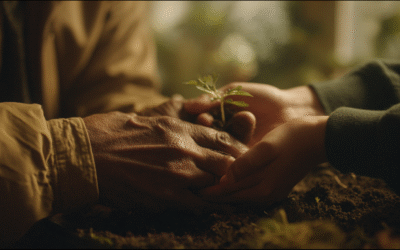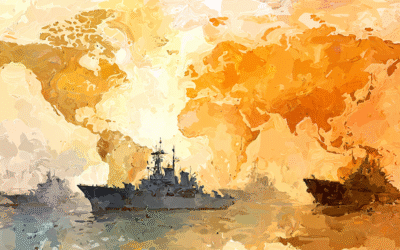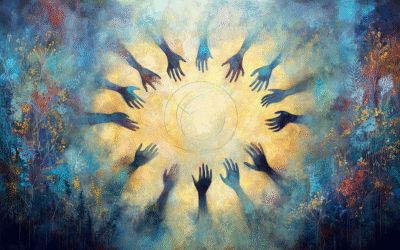There’s a line near the end of Colin Benjamin’s recent essay—BLUE AYES/BROWN NAYES—that I keep circling back to. It comes after he’s laid bare the way modern identity politics mimic Jane Elliott’s infamous 1968 classroom experiment, where third-graders turned on each other after being told that eye color determined superiority. Colin draws the connection sharply: just replace “blue eyes” and “brown eyes” with today’s cultural binaries—woke vs anti-woke, cis vs trans, privileged vs marginalized—and you see the same structure of division, performance, and moral certainty. The same instinct to sort, shame, and signal.
But then he writes this:
“Elliott’s experiment only produced empathy on the third day—after students had lived both sides of division. America hasn’t reached its third day yet. But it can.”
That stayed with me. Because that’s not just an observation—it’s a challenge. A provocation, even. What does it mean to live in the days before empathy? What kind of world have we built if the most visible social currency isn’t humility or curiosity, but allegiance?
More urgently: how do we move forward?
Colin gives us a beginning. He writes, “Not cancel. Not capitulate. Not cling to our blue or brown eyes.” And then he lays out three uncomfortable but necessary truths:
-
Identity is real, but not absolute.
-
Pain is valid, but not a monopoly.
-
Speech must be free—but power isn’t distributed evenly.
These aren’t talking points. They’re the raw materials of a new kind of political and social conversation—one that begins not in victory, but in reflection. And I want to pick them up from here. I want to trace what it might actually take to move through the fracturing, the fear, the fatigue—and toward something more whole. Something that looks, perhaps, like empathy. Or peace. Or simply, the capacity to stay in the room when it gets uncomfortable.
We’re not on the third day yet.
But maybe we can get there.
Where We Are Now
We’re tired. Not just politically, but emotionally, relationally. Tired in that deep, slow kind of way that doesn’t go away with a news detox or social media break. Something underneath is frayed.
What makes it harder is that the exhaustion is layered with a sense of performance. Every day, in every space—from protest signs to dinner tables—we’re asked not just what we think, but who we are. And not in a curious, open-ended way, but in the form of a demand: Are you on the right side of this? Do you understand the stakes? Are you saying enough? Too much? Are you safe?
Belonging has been reconfigured—not around proximity or community, but around the expression of the correct moral signal. Silence becomes suspicious. Nuance gets flattened. Doubt feels dangerous.
We’ve mistaken moral certainty for moral clarity, and the difference is not small. Certainty demands performance. Clarity requires reflection.
What Colin Benjamin points out—and what many are quietly feeling—is that identity, once a way to name lived experiences and systemic imbalances, has calcified into something more rigid. It’s not just descriptive now. It’s prescriptive. Your label predicts your politics. Your politics predict your worth.
We see this in every major debate—whether about race, gender, class, religion, or conflict zones. The script gets written before the conversation begins. The role you’re supposed to play depends not on what you say, but on who you are perceived to be.
And so we get stuck in a feedback loop:
-
If I challenge my own group’s narrative, I risk exile.
-
If I question another group’s pain, I risk cruelty.
-
If I stay quiet, I’m complicit.
-
If I speak, I better say it perfectly.
This isn’t a healthy space for democracy. It’s not even a healthy space for human relationships. It’s a stage. And we’re all a little exhausted from acting.
What’s underneath the performance is often fear—of being misunderstood, of being shamed, of being reduced to a caricature. But what emerges on the surface is defensiveness, posturing, and tribal allegiance.
It’s not that the conflicts aren’t real. They are. The histories are deep. The systems are uneven. The pain is often legitimate. But when all of that is pushed through a culture of hyper-visibility and constant moral pressure, it gets distorted. Empathy doesn’t thrive under surveillance. Dialogue doesn’t grow in binary.
And maybe most dangerously: once we sort ourselves into sides, the machinery of identity becomes self-reinforcing. The narrative becomes more important than the nuance. People become stand-ins for positions. And slowly, we lose the ability to hear anything but the echo of our own team.
That’s where we are now. Not in a war, exactly—but in a posture of war. In a constant state of rhetorical combat, even with those who might otherwise be allies.
And it’s from here, not from some imagined neutrality, that the work toward a third day has to begin.
The Truths We Must Hold
Before we can begin to move toward peace—toward a third day of empathy—we have to name a few things plainly. These aren’t comfortable truths. But they’re necessary ones. Colin Benjamin laid them out with striking clarity: identity is real, but not absolute; pain is valid, but not a monopoly; speech must be free—but power isn’t evenly distributed.
Each of these truths contains tension. And that’s the point. Peace doesn’t mean the absence of tension. It means learning to live with it—and to work through it honestly, without collapsing it into a slogan.
Identity is real, but not absolute.
To deny identity is to deny history. It’s to ignore the weight of culture, language, gender, race, religion—all the scaffolding that shapes how we’re seen and how we survive. But when identity hardens into ideology—when it stops being a window and starts becoming a wall—it narrows the self.
You are not only your label. No one is. And yet we’ve built a cultural ecosystem where that label often dictates what you’re allowed to say, how you’re allowed to feel, and which injustices you’re allowed to name.
This is especially dangerous in spaces that claim to be about liberation. When identity becomes currency, people are incentivized to perform a kind of pain in order to be heard—or to stay silent if their experience doesn’t fit the expected script. That isn’t solidarity. That’s curation.
And it’s happening across the spectrum. In progressive circles, identity sometimes becomes a litmus test for legitimacy. In conservative spaces, it’s often used as a scapegoat—“identity politics” as the great bogeyman. Both approaches miss the point. Identity is a real part of who we are. But it’s not all we are. To treat it as absolute is to strip away both complexity and agency.
Pain is valid, but not a monopoly.
One of the quiet tragedies of the current moment is how much pain goes unacknowledged—not because it doesn’t exist, but because it doesn’t fit the prevailing narrative. When suffering becomes a kind of capital—used to win moral arguments or claim political ground—it gets measured, compared, weaponized.
But pain doesn’t work like that. It doesn’t organize itself neatly along ideological lines.
The working-class white man watching his town empty out isn’t imagining his despair. The trans teenager being shouted down at a school board meeting isn’t exaggerating their fear. The Palestinian child and the Jewish grandmother both grieving lives lost to violence aren’t canceling each other out.
Different pains don’t negate each other. They coexist. They shape. They complicate.
We need to recover the language of mutual recognition—the ability to say, “Your pain matters, and so does mine.” That’s not relativism. It’s relationality. It’s the foundation of any real peace process.
Speech must be free—but power isn’t evenly distributed.
This may be the hardest truth to hold right now. Because public discourse has become a minefield—policed on all sides, filtered through platforms that reward provocation over patience, and constantly distorted by power dynamics that are too often invisible to those who hold them.
Yes, speech should be free. But the conditions under which people speak are wildly unequal. Who gets heard, who gets believed, who gets centered—these things are shaped by race, class, gender, geography, history. And pretending otherwise doesn’t make speech more free. It just makes injustice more efficient.
But the flip side is also true: protecting marginalized voices doesn’t mean silencing all others. There’s a difference between creating space and enforcing silence. The point of free speech isn’t to say whatever you want without consequence. It’s to create a culture where ideas and identities can coexist without coercion.
That means allowing discomfort. It means protecting dissent. And it means recognizing that power isn’t just held by institutions—it’s enacted in conversation, in tone, in the quiet cues of who gets interrupted and who gets asked to explain themselves.
None of this is simple. But that’s why it matters.
These three truths—about identity, pain, and speech—are not an endpoint. They’re an entry point. They are the foundation we have to build on if we want to stop reenacting Day One and Day Two—and begin the longer, slower, harder movement toward empathy.
Toward the third day.
What Peace-Building Really Looks Like
Peace isn’t the absence of conflict. It’s what happens when people choose to stay in the room after the conflict. After the scripts fall apart. After the adrenaline fades and the slogans no longer feel satisfying.
It’s not passive. It doesn’t mean letting go of truth or justice or even anger. In fact, peace-building is often more demanding than protest. Protest is immediate—urgent and visible. Peace-building is slow. It requires a kind of stamina we rarely celebrate.
We like to imagine peace as a soft word. But real peace-building is built of harder things: restraint, risk, repair.
Let’s name what that looks like.
Reflection over Reaction
We’re living in a culture of instant response. A headline breaks, a post goes viral, and within minutes the performance begins—outrage, rebuttal, alignment. Everyone needs to be seen saying something, and it better be the right thing, right now.
But reflection requires time. It requires us to pause before speaking, and to ask: What is this really about? What’s underneath the noise?
That kind of slowness feels dangerous in a world that rewards speed. But it’s essential if we want anything deeper than applause or algorithmic reach. Reflection doesn’t mean silence. It means considering the consequence of your words—not just to yourself, but to the conversation.
Narrative over Ideology
Ideology reduces people to positions. Narrative restores the self. If you know someone’s story—their real story, not their resume of affiliations—it becomes harder to flatten them into an enemy.
A Palestinian mother’s memory of her son’s final meal. A Jewish father’s fear of generational trauma repeating. A queer teacher navigating parent-teacher meetings in a small-town school. These aren’t rhetorical devices. They’re lives.
Peace-building insists on story because story makes complexity audible. Ideology demands loyalty; story invites listening.
This is why restorative justice circles begin with personal narrative. Why transitional justice processes—like those used in South Africa or Rwanda—center testimony. When people speak from story instead of script, they break open the gridlock. Not because everyone agrees—but because everyone is seen.
Listening with Stakes
It’s easy to listen when there’s nothing at risk. The hard part is listening when the stakes are personal—when you feel implicated or threatened or exposed.
But that’s exactly where peace-building lives: in the space where listening hurts, but you stay anyway.
This doesn’t mean agreement. It means staying curious. Holding space for discomfort. Learning to hear “you’re wrong” without hearing “you’re worthless.”
Most of us have never been taught how to do this. And it shows. Our collective emotional vocabulary is paper-thin. We confuse discomfort with danger. We hear critique as condemnation. We collapse complexity into betrayal.
Peace-building invites us to rebuild that muscle—slowly, imperfectly. It teaches us to sit with tension, to allow multiple truths to breathe, and to recognize that the point of listening isn’t to win. It’s to connect. Even if that connection is quiet, or temporary, or unresolved.
Making Space, Not Demands
So much of our current discourse is driven by demands: Say the right thing. Use the right words. Prove your belonging. And often, those demands are rooted in real hurt.
But the path to the third day isn’t paved by coercion. It’s built by invitation.
Peace-building doesn’t mean abandoning accountability. It means reframing it. Instead of asking, “Who can we shame into agreement?”, it asks, “How can we create conditions where growth is possible?”
This often means resisting the temptation to correct every wrong in real-time. It means learning when to speak, and when to make space for someone else to step in.
It’s not glamorous work. It doesn’t go viral. But it’s how culture actually shifts—not through declarations, but through presence.
The Third Day
The third day isn’t a destination. It’s not a future we arrive at, arms raised in moral triumph. It’s quieter than that. Stranger, even. It’s a kind of turning—subtle, often internal. The moment when performance gives way to presence. When you stop trying to win, and start trying to understand. When the room doesn’t feel like a courtroom anymore, but something closer to a commons.
In Jane Elliott’s classroom, the third day began when the children had sat in both roles—oppressor and oppressed—and could finally see what the system had done to them. Only then could empathy emerge—not as a concept, but as a felt experience. Not as pity, but as recognition.
That’s the invitation. Not to erase identity, not to flatten history, but to live in a deeper awareness of how much we’ve all been shaped—by fear, by pride, by grief, by misrecognition—and how little that’s talked about in our public conversations.
So what does the third day look like in practice?
It looks like slowness, even when the moment demands speed.
It looks like curiosity, even when your side is certain.
It looks like compassion that isn’t cheap, and accountability that isn’t cruel.
It sounds like someone saying, “I don’t agree with you—and I still want to understand.”
It sounds like someone asking, “Where did you learn that? Who taught you to be afraid?”
It sounds like someone confessing, “I didn’t know what I didn’t know.”
The third day isn’t soft. It’s just not loud. It’s not the Twitter war. It’s not the panel show. It’s not the rallying cry that demands others fall in line. It’s the quiet talk at the edge of the room, where someone finally feels safe enough to ask a real question.
It’s the work of trust. Of staying human, even when every cultural instinct says to pick a team, harden your stance, and call the other side lost.
The third day might not go viral. It may not satisfy the part of us that wants clarity, speed, and moral victory. But it offers something else. Something more sustainable.
Less certainty. More clarity.
Less outrage. More truth.
Less tribal theatre. More shared air.
It offers the possibility that we might become something else. Not just better winners. But better listeners. Better builders. Better ancestors.
Because here’s the thing about the third day: it doesn’t just arrive.
We choose it. Or we don’t.
When Colin Benjamin wrote that “America hasn’t reached its third day yet—but it can,” it wasn’t just a statement of hope. It was a line drawn in the sand. A moment of pause, of possibility. It acknowledged something most of us feel but rarely name out loud: that we’re stuck. Still playing roles, still acting out old scripts, still performing pain and power on a stage that never goes dark.
But it also offered something rare in this cultural moment—an opening. A belief that things might be different, not by accident, but by intention. Not through punishment or purity or the perfect post—but through reflection, and presence, and practice.
The third day isn’t a miracle. It’s a habit. It’s a discipline. It’s a refusal to be governed by the terms of a system that only knows how to sort us into sides. It begins wherever someone chooses to stay curious, to tell the truth with tenderness, or to listen longer than is comfortable.
It won’t win every argument. It won’t trend.
But it might, quietly, start to make peace possible again—not as a national headline, but as a human encounter. One room. One conversation. One person at a time.
Not cancel. Not capitulate. Not cling.
Just keep walking—toward that third day.










0 Comments